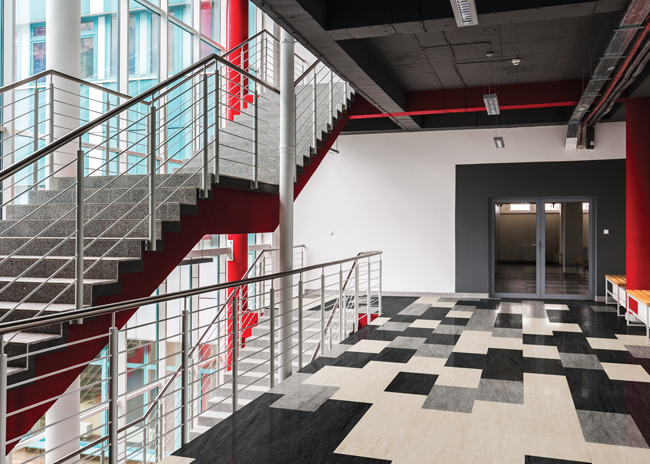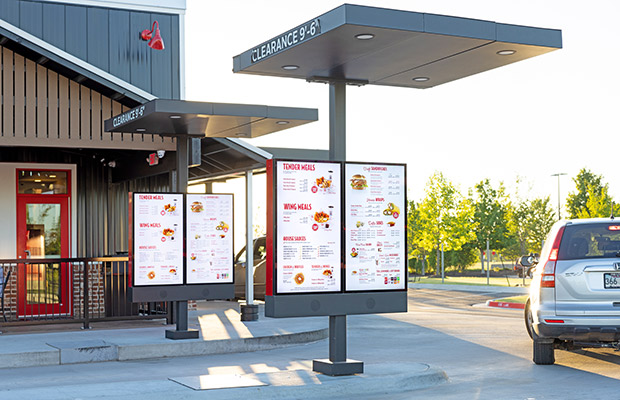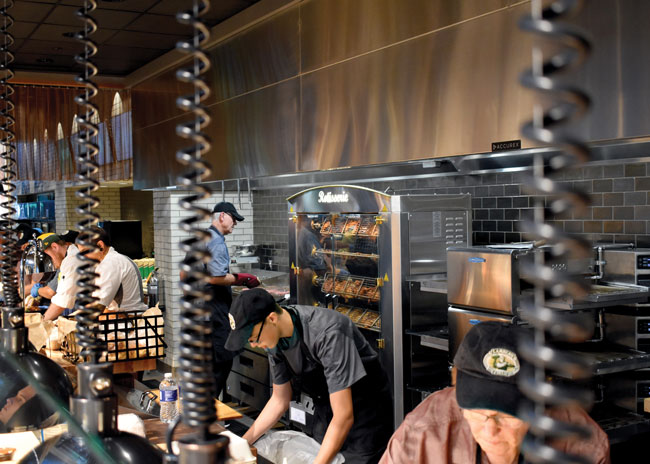
Sustainable design at first may have seemed like just a flash-in-the-pan trend, but it’s now found in virtually every type of foodservice operation, from schools to fast-food establishments to white-tablecloth restaurants. Designers have found that beyond the obvious environmental benefits, there can be significant cost savings in using sustainable building practices. Ray Soucie, Design Director for Webb Foodservice Design in Portland, Ore., sees sustainable design increasing, calling it “huge on the building and design side. It’s been so since LEED was originally rolled out.”
In Soucie’s view, one of the advantages of the initial introduction of the LEED program was that it was voluntary, not mandatory. Designers and contractors who may have been initially skeptical of the program became converts after they saw the long-term energy savings inherent in sustainable design. “Once those who weren’t as aware of the need to design sustainably became aware of the savings, it became a no-brainer to invest. It was just good business sense.” He adds that some of the original guidelines and goals set out in the LEED program have now been worked into municipal codes.
On the horizon, Soucie sees more operations going ventless, with ventless cooking and dishwashing equipment leading the charge. Beyond the immediate cost savings in not having to install a ventilation system and exhaust ducts, the operator can realize longer-term energy savings.
The stories on the following pages can help with sustainable building and design practices for any foodservice operation.
Berner Air Curtains for Comfortable,Sustainable Restaurants
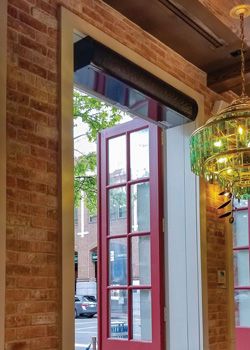 Berner Air Curtains save energy while helping to ensure customer satisfaction.Every restaurant has a front door. In most restaurants, that door opens to the outside. When customers open this door in the winter, cold air from the outside streams into the restaurant, making the space uncomfortable for patrons and staff. Customers don’t want to sit at a table or the bar if they are cold, so they ask to be moved — or they leave. Cold air that enters the dining area can trigger the HVAC units to run more often, making the already warm area far away from the entrance unpleasantly hot while they work to provide heat to the colder space near the door. Not only does this exacerbate the comfort issue, but it also increases heating costs.
Berner Air Curtains save energy while helping to ensure customer satisfaction.Every restaurant has a front door. In most restaurants, that door opens to the outside. When customers open this door in the winter, cold air from the outside streams into the restaurant, making the space uncomfortable for patrons and staff. Customers don’t want to sit at a table or the bar if they are cold, so they ask to be moved — or they leave. Cold air that enters the dining area can trigger the HVAC units to run more often, making the already warm area far away from the entrance unpleasantly hot while they work to provide heat to the colder space near the door. Not only does this exacerbate the comfort issue, but it also increases heating costs.
There’s an effective and cost-efficient way to solve these wintertime problems: Berner Air Curtains. They’re easy to install and help keep the warm air in and cold air out of the restaurant while keeping fumes and cigarette smoke on the sidewalk. Efficient energy usage, comfort and indoor air quality are important goals for any operation that is trying to be more sustainable, and these air curtains help operators get the most out of their “people-planet-profit” initiatives. When the door is open, Berner Air Curtains save energy and promote customer comfort and satisfaction, ensuring that every seat in the front of the house is comfortable. And when it’s hot outside, air curtains allow customers to enter while keeping air-conditioning costs down and flying insects out. For energy savings and sustainable design, Berner Air Curtains are always a smart choice.
Kitchens To Go: Make Temporary Kitchens Sustainable
A Q&A with Ralph H. Goldbeck, AIA, Partner, Kitchens To Go built by Carlin
Kitchens To Go units seem to be the ultimate in sustainability because they’re reusable.
Ralph Goldbeck: We tell people that they’re recycled kitchens, in a sense. They’re modular buildings that are reused from project to project.
How is modular construction a greener option?
RG: You’re building in a controlled environment. When you build in a factory environment, you’re essentially bringing all your materials and subcontractors into a controlled environment, so you don’t have excess transportation to a remote site. It also reduces the amount of waste because things are very calculated and engineered so it minimizes the waste that you see on a regular construction site.
You also repurpose and reuse equipment.
RG: We do. In our Kitchens To Go lease fleet, we have probably 4,000 pieces of equipment in our renovation center in Etna Green, Ind. We bring the units back in house after a lease project, remove all the equipment, recondition it and put it back in inventory. As the units get repurposed to go back out for another project, we rebuild the cook line out of our fleet of equipment. So all that equipment is also being reused and recycled.
So your units go beyond just being sustainable.
RG: They’re very energy-efficient. We are typically installing them in a remote location, so we purposely designed them to minimize the energy footprint that is required by a complex. We’re also looking at sustainable ways of using daylighting, increasing insulation and using high-efficiency Energy Star appliances so we can minimize that energy footprint.
Making Sustainability Beautiful and Durable
A Q&A with Heidi Vassalotti, LEED AP ID+C, Director of Strategic Accounts, Crossville
 Why is porcelain a particularly sustainable material?
Why is porcelain a particularly sustainable material?
Heidi Vassalotti: Porcelain tile is made from naturally occurring minerals. While these aren’t necessarily rapidly renewable, they’re abundant, covering up to 60 percent of the earth’s crust. Porcelain is fired on average at 2200 degrees F, creating an inert end product. Therefore, it doesn’t off-gas — so it causes no harm to human health.
Certified porcelain tile withstands extremely high traffic with minimal wear. It has an average life-span of more than 50 years. Unlike other hard surfaces, porcelain tile doesn’t require sealing, waxes or
harmful chemicals for cleaning. Porcelain tile is easy to maintain.
What are the benefits for the operator in using sustainable materials?
HV: Porcelain tile is the perfect intersection between design and durability. The aesthetics allow operators to achieve any design they dream of. The sizes and finishes allow for proper slip resistance. It withstands climate conditions and won’t be damaged by furniture.
Crossville was among the first manufacturers to receive Green Squared® certification from the Tile Council of North America. What does that mean, and what’s in it for the end user?
HV: Green Squared® certification sets the standard in the tile industry for sustainable products. It considers a myriad of factors to determine product sustainability. This Green Squared designation eliminates guesswork and helps end users specify confidently.
Talk a little about Crossville’s Tile Take-Back® program.
HV: Crossville invented a method for recycling fired porcelain tile — a true revolution for our industry. This capability allowed us to launch Tile Take-Back and keep literally hundreds of thousands of pounds of tile from being landfilled.
We “take back” our own scrap and others’ previously installed tile and recycle it to make new products. In 2011, we expanded the program through a partnership with sanitary ware manufacturer TOTO USA® to recycle their pre-consumer porcelain toilets and other castoffs that would’ve been landfilled.
Today, every piece of tile we make has recycled content, and we are the first-ever net consumer of tile waste — meaning we recycle more than we produce.
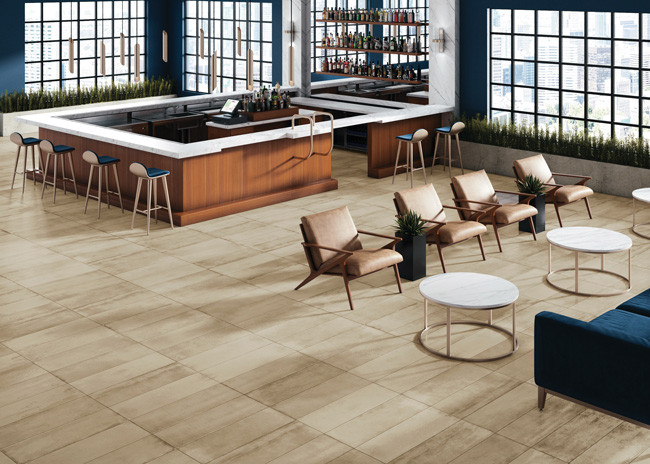 Crossville’s Reformation tile stylishly brings the look of concrete indoors.
Crossville’s Reformation tile stylishly brings the look of concrete indoors.
How can Crossville’s new products help operations be sustainable?
HV: Being sustainable includes a product’s impact on the environment and human health, as well as its ability to
perform long term. At Crossville, we innovate new collections that embody these attributes. Our latest product introductions are great examples. Astral Plane is a large-format collection in four rich colors; Reformation has a nuanced “concrete” look in plank sizes.
Crossville also has some new technological advances that are sustainable.
HV: A great example of technological tile innovation is Crossville’s gauged porcelain tile panel collections. The lines come in 1mx3m outer dimensions with thicknesses of 3+mm or 5.6mm and offer superior sustainable attributes. Commonly used for tile-over-tile-renovations, our panel products can eliminate the need for demolition — meaning no old tile goes to landfills.
Sustainable Seating from MTS
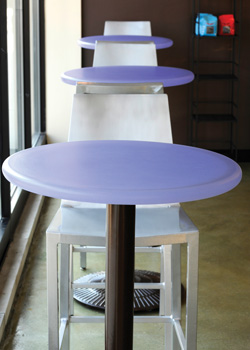 MTS Seating’s SierraSolid table tops are made from recycled acrylic material.A restaurant that wants to be truly sustainable has to look at every part of its operation. Changes in the HVAC system can help use energy more efficiently. Water consumption needs to be carefully monitored to avoid overuse. Spent resources, such as wastewater or garbage, must be disposed of in ways that are friendly to the environment. In short, every part of the restaurant’s design and operation needs to be considered in terms of sustainability and efficient use of resources.
MTS Seating’s SierraSolid table tops are made from recycled acrylic material.A restaurant that wants to be truly sustainable has to look at every part of its operation. Changes in the HVAC system can help use energy more efficiently. Water consumption needs to be carefully monitored to avoid overuse. Spent resources, such as wastewater or garbage, must be disposed of in ways that are friendly to the environment. In short, every part of the restaurant’s design and operation needs to be considered in terms of sustainability and efficient use of resources.
One area that’s sometimes overlooked in sustainable restaurant design is the furniture — especially the tables, chairs and barstools. How they’re made, and what they’re made of, is just as important as the other facets of the operation when it comes to sustainability.
For years, MTS Seating has focused on producing its products sustainably and efficiently. Since 2009, the entire line of MTS chairs and barstools have been GREENGUARD® Indoor Air Quality Certified. This means that seating products manufactured by MTS do not contribute to indoor air pollution. To attain the internationally recognized GREENGUARD certification, products must undergo rigorous third-party testing to determine their impact on indoor air quality and must be retested regularly to maintain the certification.
By using GREENGUARD-certified products and materials, operators can reduce the amount of indoor air pollutants to a fraction of current levels. GREENGUARD-certified products are recognized by a number of sustainable building programs, including the U.S. Green Building Council LEED Rating System and the National Association of Home Builders Green Building Guidelines.
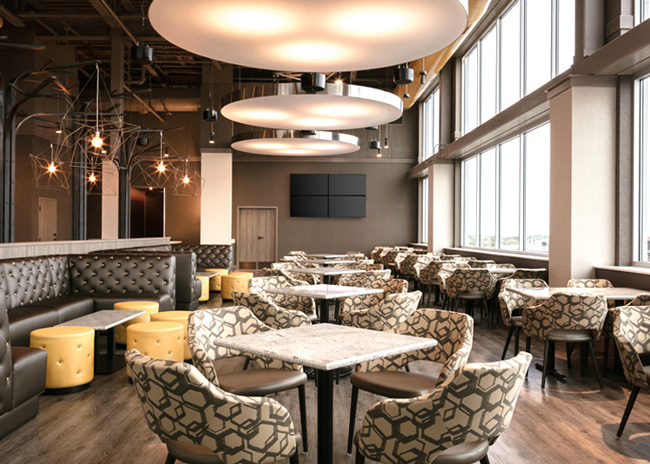 MTS Seating’s Inessa barstools in VUE Rooftop in Iowa City, Iowa, have a recycled steel frame and plant-based foam.
MTS Seating’s Inessa barstools in VUE Rooftop in Iowa City, Iowa, have a recycled steel frame and plant-based foam.
Working Sustainably
Making products that are GREENGUARD certified is just one of the ways that MTS Seating acts sustainably at all points in its manufacturing process. Take the Innovative Resin Technologies (IRT) used in the Dine Focus line of chairs. IRT recycles common plastic items, like liquid detergent bottles, into a durable seating material. The water-based wood stains and clear coats MTS uses, as well as its powder coat metal finishing, avoid the release of solvents into the environment. The COMFORTbliss foam padding used in MTS chairs contains natural plant polyols in place of petroleum-based polyols. All veneer wood products used by MTS are procured through Forestry Best Management Practices established by the EPA. On the production line, recycled and sustainably produced products are used as much as possible. For example, the steel used in MTS products contains approximately 35 percent recycled material. Every year, the company recycles more than four million pounds of scrap steel, aluminum, wood and corrugated materials from its three manufacturing facilities in Michigan. And at the end of their life-span, an average of 84 percent of the materials used in MTS Seating products can be recycled.
All of these efforts can help operators attain sustainability-based certifications. More importantly, they are critical parts of MTS Seating’s SynerGreen philosophy — making continuous environmental improvements in its processes and products while practicing sound business principles that focus on satisfying its customers’ needs.

